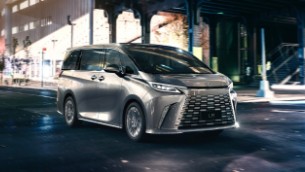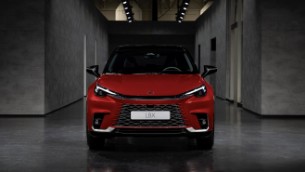Meet the all-new Lexus RZ, the luxury brand’s first battery EV
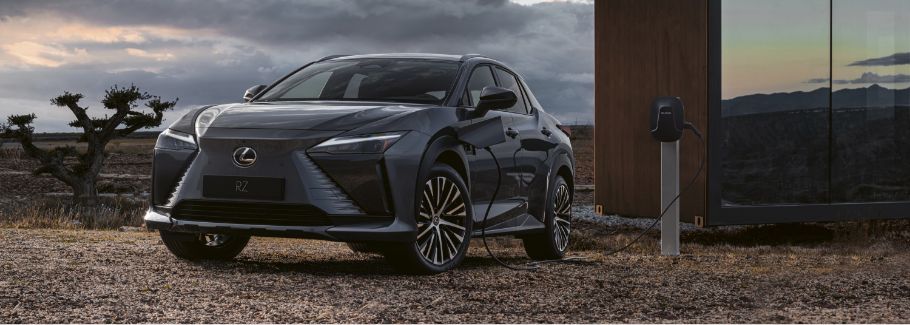
Lexus is proud to unveil details of the all-new 2023 RZ 450e, the luxury brand's first global Battery EV (BEV).
Since the launch of the RX400h in 2005, Lexus has been a pioneer of electrification within the luxury market. As with the first RX hybrid model, Lexus engineers have imbued the brand's hybrid vehicles with an excellent driving identity and environmental performance. Under the ‘Lexus Electrified' vision, Lexus aims to invigorate all guests' authentic love for driving exhilaration, and in doing so, will broaden its Lexus Electrified portfolio of hybrid electric vehicle (HEV), battery electric vehicle (BEV) and plug-in hybrid electric vehicle (PHEV) products to exceed the needs and expectations of a more diverse set of luxury buyers.
The portfolio expansion will move Lexus toward another essential goal: The realization of a sustainable global society. Lexus will contribute to achieving a carbon-neutral society by offering a full lineup of BEVs in all categories by 2030. Five years later, Lexus seeks to attain 100% BEV sales globally. To meet these challenges, Lexus will rigorously improve its products, along with the expertise of its personnel, by repeating "drive and fix" development at Toyota Technical Center Shimoyama (TTCS), Lexus' new operational base.
"We believe that Lexus, an established luxury automaker, should continue pursuing the creation of exciting cars while respecting nature and the global environment to achieve a carbon-neutral society," said Takashi Watanabe, chief engineer, ‘Lexus Electrified,' Lexus International. "The RZ has been developed with the aim of creating a uniquely Lexus BEV that feels secure to ride in, is pleasing to the touch, and is exhilarating to drive. DIRECT4, the core technology of ‘Lexus Electrified,' is all-wheel drive system that achieves quick and linear response according to driver input. We will continue to take on the challenge of providing customers with new experiences and a uniquely Lexus BEV driving experience."
As Lexus' first global BEV model, the all-new RZ marks Lexus' transition into a BEV-centered brand, and it embodies the unique Lexus vehicle design and driving experience made available through advanced, electrified technology. The utilization of a BEV-specific platform (e-TNGA), as well as a lightweight and highly rigid body, has enhanced the fundamental performance of the vehicle by achieving optimal weight distribution through ideal placement of the battery and motor. In addition, the DIRECT4 all-wheel drive system and the adoption of a new steering control and available Steer by Wire system enable vehicle control that is more true to the driver's intention.
The exterior design expresses the seamless acceleration and dynamic torque-filled performance specific to BEVs. Lexus' identifiable spindle grille is replaced by a BEV Spindle Body. The new front bumper design focuses on aerodynamic efficiencies, optimized proportions and style, versus serving the cooling and exhaust needs of an internal combustion engine. This styling evolution ushers in a new Lexus aesthetic and establishes a new design direction for BEV offerings.
Within the spindle body is a minimalist, spacious interior focused on amplifying a sustainable mobility message and Sustainability Development Goals (SDGs) through its application of mindfully sourced materials. Though simplistic, the space is luxurious thanks to its crafted touches and advanced technologies. In addition, the cabin features a standard panoramic roof which visually opens the space, while passenger comfort is improved by a highly efficient heating system featuring a Lexus-first radiant heater.
THE EVOLUTION OF THE "LEXUS DRIVING SIGNATURE" THROUGH ELECTRIFICATION
The "Lexus Driving Signature" (LDS) is a uniquely Lexus driving experience that aims to achieve predictable, linear response according to the driver's intentions. In the RZ, the high-precision motor torque control and optimal battery and motor placement help to achieve ideal weight distribution and high response.
This concept is called "The Natural" and is based on the DIRECT4 all-wheel drive system that controls front and rear drive force according to driving and road surface conditions. It achieves driving performance where the vehicle directly responds according to the driver's input, taking the "Lexus Driving Signature" to an even higher level.
DIRECT4: SUPPORTS A MORE ENGAGING DRIVING PERFORMANCE
DIRECT4 and the newly developed high-output electronic axle (eAxle) motor continuously controls the drive force of the four wheels with high precision. It works according to the ground contact load of the vehicle regardless of road surface and driving conditions to achieve an exhilarating driving experience in line with the driver's intention.
The DIRECT4 distribution control uses wheel vehicle speed, acceleration and steering angle sensor information to control front-to-rear drive force ratio distribution between 100:0 and 0:100. This contributes to improved start-up acceleration, handling stability and low power consumption. The system uses an approximate front-to-rear drive force ratio distribution between 60:40 and 40:60 to minimize vehicle pitch during launch and straight-line acceleration, thereby achieving a direct acceleration feel. Vital information such as cornering speed and steering angle help to optimize drive force distribution according to various driving conditions and helps attain excellent handling stability. When the steering wheel is turned, drive force is biased to the front wheels (distributing drive force between 75:25 and 50:50) so RZ responds nimbly and provides excellent steering feel. When exiting a corner, torque distribution to the rear wheels is further increased (between 50:50 and 20:80) to ensure ample traction while controlling vehicle pitch. For RZ, engineers have achieved a refined driving feel by orchestrating the seamless operation of their accumulated electrification and dynamic vehicle movement control technologies.
The newly developed eAxle fully integrates the motor, transaxle and inverter within a compact unit to benefit cruise range, spacious interior and excellent design. The front eAxle is packaged with a short front/rear system layout, while the rear eAxle features a low-profile layout contributing to increased interior and cargo space. In addition, the use of a high-efficiency inverter having an element in the rear, contributes to an increase in cruise range.
A new pressurization unit enables coordinated front and rear regenerative braking through independent front and rear hydraulic control. The new braking system aims to provide seamless, direct and controlled braking under the direction of the Lexus Driving Signature. Based on Lexus' hybrid electric technology experience and achievements over the years, the regenerative braking system improves regenerative energy efficiency to increase cruise range, while enhancing brake feel. Stable vehicle posture is achieved by optimizing the distribution of braking force to the front and rear wheels in response to the amount of braking by the driver. Furthermore, ergonomic brake pedal pads are used for easy pedal changes and pedal depression.
AVAILABLE STEER BY WIRE WITH INNOVATIVE STEERING CONTROL ELEVATE THE HUMAN-MACHINE CONNECTION
Available in the U.S. at a future date, the Lexus-first Steer by Wire system enables the electronic exchange of steering and road surface information between the advanced steering control and tires via electrical signals, not mechanical linkage.
The control's steering angle is set at approximately 150 degrees, thus greatly reducing the driver's workload and eliminating the need for hand-over-hand operation at intersections, U-turns, parking, winding roads and other driving situations. Unhindered by a sizeable standard steering wheel, designers crafted the steering control's compact shape and lowered the instrument meter's placement to encourage driver engagement and environmental awareness.
A cockpit space encouraging even more engagement with the car has been achieved by minimizing driver eye movement during driving and naturally drawing the driver's eyes forward. With Steer by Wire enabling the electronic exchange of steering and road surface information between the steering wheel and tires via electrical signals, Lexus focused on the quality and transmission speed of important driving information. The system achieves maneuverable and confidence inspiring performance through precise judgment, by blocking out unnecessary vibrations from the tires and brakes, only relaying vital driving information such as road information to the driver.
When Lane Tracing Assist is activated, the wheels are controlled as needed, allowing for gentle steering and vehicle movement. Furthermore, in addition to the vehicle's overall maneuverability, the system provides nimble and agile performance on winding roads and high-speed stability on the highways by optimizing the steering gear ratio according to vehicle condition.
IMPROVED FUNDAMENTALS, ENLIVENED PERFORMANCE
RZ utilizes a Lexus-first, dedicated BEV platform (e-TNGA) to significantly evolve the vehicle performance and provide the exhilarating joy of driving. The platform offers stability and ride comfort by mounting the battery under the vehicle floor creating a low center of gravity. The body is strengthened by reinforcing the radiator support area and adding a V-shaped brace for excellent handling performance. In addition, the tow bar and fender braces improve steering response, while the reinforcement in the lower back section improves rear tracking.
Laser screw welding, structural adhesives and laser peening welding technologies are proactively used to join the body frame to improve handling stability and ride comfort. The addition of a double ring structure and a highly rigid foaming agent prevents distortion to reduce deformation of the rear luggage opening.
Up front, RZ rides atop MacPherson strut type suspension, while its rear uses a trailing arm double wishbone configuration. For the first time, Lexus uses Frequency Reactive Dampers (FRD*1 II), a frequency-sensitive absorber that alters the dampening force on the extension stroke in response to road surface frequency input. The FRD setup gives a high level of handling stability without compromising ride comfort. With FRD and optimized dedicated BEV platform, key Lexus Driving Signature traits such as the precise control of sprung weight, along with natural posture changes, a tactile steering feel and the linear responses of steering, braking and acceleration operations are enabled.
A QUIET SPACE HAVING A SPECIAL LEXUS SOUND
To bring the exhilaration of driving through sound, Lexus engineers created expressive in-cabin sounds to convey the exhilaration of driving. Engineers matched sound frequencies to the vehicle's speed and sound levels during dynamic actions such as acceleration. In addition, the underfloor battery functions as a sound barrier and the entire perimeter of the hood opening is sealed to eliminate noise caused by turbulent airflow. Unwanted noise is also suppressed through the use of front/rear seat acoustic glass, and a new weatherstripping cross section creates quiet, conversation-friendly space, even when driving at high speeds.
A BEV SYSTEM INFORMED LEXUS' HEV DEVELOPMENT
Lexus developed a system that maximizes the advantages of the dedicated platform by using technology and knowhow derived from the brand's hybrid vehicle development. The use of BEV-exclusive, high-capacity batteries and silicon carbide power semiconductor elements in the inverter*2, as well as the incorporation of low-loss technologies cultivated in the development of HEVs, contribute to extending the single-charge cruise range of the vehicle. The current U.S. manufacturer-estimated range is up to 225*3 miles with 18-inch tires.
*1 FRD: Frequency Reactive Damper
*2 First use of silicon carbide power semiconductor elements in the inverter by Toyota/Lexus
*3 Current U.S. market manufacturer-estimated range
A DESIGN THAT PURSUES A UNIQUE LEXUS BEV IDENTITY AND PROPORTIONS BORN FROM A DYNAMIC DRIVING EXPERIENCE
The all-new RZ continues the design language of the next generation of Lexus by pursuing a unique identity and proportions born from a dynamic driving experience. The design concept is "Seamless E-Motion," expressing seamless acceleration and a dynamic sense of torque unique to a BEV. Furthermore, the elimination of the internal combustion engine has changed the functional requirements of the front end and challenged Lexus to create a new visual identity through the adoption of a "spindle body" design.
The interior is inspired by the BEV's dynamic performance, presenting a clean and nimble image. A sense of refinement and high-quality craftsmanship exists, even within a space pursuing functional essence. Based the innovative tazuna concept, the cabin welcomes its passengers with an airy feeling and intuitive controls specifically oriented around the driver. As such, the tazuna inspiration seamlessly connects human with machine and emphasizes concentration on driving.
SHAPED FOR AERODYNAMIC PERFORMANCE
RZ's spindle shape design generates a distinctive roof spoiler to suppress aerodynamic force acting on the body in a crosswind. This ensures a more stable driving feel. The center of the roof is shaped to allow air to flow smoothly from the sloped rear glass surface to the rear of the vehicle. The ducktail shape on the end of the trunk reduces aerodynamic drag by balancing the aft air flow. In addition, the generated downforce contributes to a stable driving feel. An undercover is used to flatten the underbody to reduce aerodynamic drag.
Having no engine to cool results in a low hood design and minimal front grille opening. The grille uses a grille shutter to improve aerodynamic efficiency. When cooling air is not required, the grille shutter is closed to reduce air resistance.
The seamless acceleration and dynamic performance of BEVs is expressed in the exterior design. Lexus' identifiable spindle grille is replaced by a BEV Spindle Body. The new front bumper design focuses on aerodynamic efficiencies, optimized proportions and style, versus serving the cooling and exhaust needs of an internal combustion engine. This styling evolution ushers in a new Lexus aesthetic and establishes a new design direction for BEV offerings.
Within the spindle body is a minimalist, spacious interior focused on amplifying a sustainable mobility message and Sustainability Development Goals (SDGs) through its application of mindfully sourced materials. Though simplistic, the space is luxurious thanks to its crafted touches and advanced technologies. In addition, the cabin features an available panoramic roof which visually opens the space, while passenger comfort is improved by a highly efficient heating system featuring a Lexus-first radiant heater.
From the side, the front fenders seemingly wrap around the wheels and tires, then flow rearward to express a powerful forward-moving momentum. The strong three-dimensional shape over the rear fenders emphasizes the tires' width and communicate the dynamic performance image of DIRECT4. In addition, the flowing contrast of the doors' sculpted shapes aims to achieve a captivating and scintillating surface.
The rear of the BEV features a clean and simple horizontal design matched to hips highlighting the wide stance; it is a look that accentuates the RZ's torque-filled performance identity. A new spelled out LEXUS logo (as first seen on the recently launched NX and LX) resides on the horizontal rear combination lamps. The lowered center portion of the red lens accentuates the logo type and emphasizes a sharp look.
Five exterior colors are also available, including "Ether," which evokes the nimble driving performance of BEVs. Furthermore, an available bi-tone color scheme lays solid black from the front of the spindle body to the upper hood and roof.
INSIDE: AN EXPANSIVE AND MINIMALISTIC, WELCOMING SPACE
The RZ's cabin is a minimalist, yet airy and maximally appointed luxury environment. The flowing shape from the doors integrates with the low positioned instrument panel. The door trim and console passing between the driver and passenger seat creates a clean, wide-open feel. In addition, the ultra-suede door trim ornamentation, seats, and upper wood-grain console create a refined omotenashi, or anticipatory hospitality, space.
The long wheelbase provides a spacious rear seat space with a couple distance of 1000 mm (39.3 in). In addition, the rearward peaked cabin silhouette allows for ample rear headroom providing a sense of spaciousness for the passengers. The available panoramic roof further lends a sense of wide openness and front-to-rear expansiveness.
Two types of seat materials are used, including Ultrasuede, an upholstery material that pursues a sense of warm refinement using 30%-bio-based sustainable materials. The combination of a clean, modern space and simple surfaces with a focus on texture, expresses a welcoming sense of freedom.
The front cockpit, based on the tazuna concept, advances Lexus' human-centered philosophy. Tazuna represents the reins riders use to control horses. With steering wheel switches that are synced with the available Head-Up Display (HUD), drivers can control functions such as navigation, audio, and drive mode select while concentrating on driving.
Drivers and passengers can experience three interior colors options, including Orage, Palomino and Dapple Gray/Black. In addition, the world's first Shadowy illumination changes the shade of light projected on to the door trim ornament when the doors are opened and closed, adding new flair to the interior space.
ADVANCED SAFETY TECHNOLOGIES BASED ON A HUMAN-CENTERED APPROACH
The RZ uses the latest Lexus Safety System+ 3.0 set of driving aids, including standard Pre-Collision System, Dynamic Radar Cruise Control, Lane Departure Alert and Emergency Driving Stop System.
LSS+ 3.0 on the 2023 RZ includes some additional features offered with the available driver monitor system.
- Pre-Collision System [PCS]: The driver monitor system checks the driver's condition, and if it is determined that the driver is distracted or drowsy, judged by how often the driver looks away from the road, the system will provide an earlier timing alert and braking to help avoid a collision and/or possible damage.
- Dynamic Radar Cruise Control [DRCC] (with full-speed follow function): While enabled, the driver monitor system will check to see if the driver is attentive, and will judge the distance from the preceding vehicle, adjusting based on the distance (time) setting (four levels available) and automatically brake when too close.
- Lane Departure Alert [LDA]: When the driver monitor system is engaged, the system will detect the driver's level of alertness, and, if it determines the driver is inattentive, the system activates either the alert or the steering assist at an earlier time than usual.
- Emergency Driving Stop System [EDSS]: When Lane Trace Assist (LTA) is activated, if the driver monitor system determines that the driver becomes unable to continue driving the vehicle, the system will decelerate the vehicle and stop within the current lane to help avoid a collision or reduce the impact of a collision. To do this, the system first warns the surroundings by flashing the hazard lamps while gently decelerating the vehicle until the vehicle comes to a full stop.
Available advanced Park with remote function expands support for parallel parking. In addition to conventional back-up parking, forward-facing parking is now supported, enabling forward-facing/back-up exit.
Additional driver and passenger comforts include radiant heaters1 to comfortably warm the passenger's knees while working with the air conditioner to provide a warm temperature at a reduced rate of battery consumption.
Both driver and passengers can enjoy the wide-open space created by the panoramic roof which is equipped with a Lexus-first, available dimming function, which instantly reduces the amount of light entering the cabin area.
*1 Located at the bottom of the steering column and at the bottom of the passenger instrument panel
ELEGANT, INTUITIVE MULTIMEDIA SYSTEM AND CONNECTED SERVICES
The RZ will feature the North American-developed Lexus Interface multimedia system recently launched on the NX and LX. The system will be accessible via voice commands and a 14-inch touchscreen.
The 2023 Lexus RZ 450e is expected to go on sale towards the end of 2022.
PREMILINARY SPECS
Main specifications of the new RZ (prototype)
| Overall length | 4.805 mm (189 inches) |
| Overall width | 1.895 mm (74.6 inches) |
| Overall height | 1.635 mm (64.4 inches) |
| Wheelbase | 2.850 mm (1.12.2 inches) |
| Tire size | 18/20 inches |
| Cruise range | Up to 225 miles (U.S. manufacture-estimate) |
| Battery capacity | 71.4kWh |
| Output (kW) | Front: 150 (kW)Rear: 80 (kW) |
*1 DIRECT4 is a registered trademark of Toyota Motor Corporation.
*2 j-WLTC mode development target value

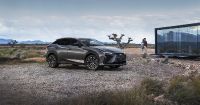

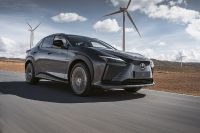
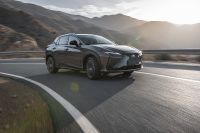
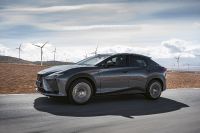
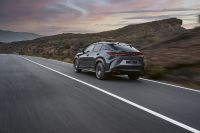
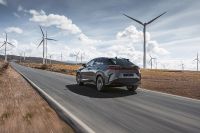
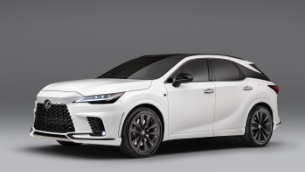
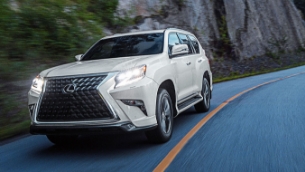
![Lexus RX [US]](http://www.automobilesreview.com/uploads/2022/09/2023-lexus-rx-us-version-ff.jpg)
